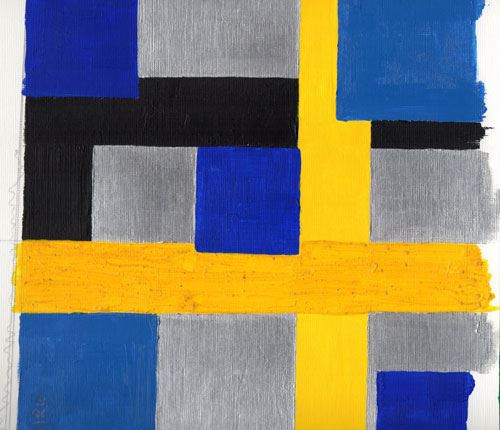Further Thoughts - London - 2014
In the new twelve paintings I have shown in London in 2014 I have sought to reflect upon the writings of the 20th-century radical contemplative monk, Thomas Merton - theologian, writer, social activist, poet and artist - and upon his search for truth which has always fascinated me.

© Robert Wright
A complicated, intellectual, sociable and very human holy man, Merton's life can be seen as his living out the belief that "if you dare to penetrate your own silence and dare to advance without fear into the solitude of your own heart, ... you will truly recover the light and the capacity to understand what is beyond words ... it is the intimate union in the depths of your own heart, of God's Spirit and your own inmost self, so that you and He are in all truth One Spirit." (William H. Shannon, Thomas Merton’s Dark Path, New York: Farrar Strause Giroux,1981, p221) Merton wrote in his autobiography The Seven Storey Mountain that he had learned from his father (who was an artist) 'that art was contemplation' and this was confirmed for him whilst completing his master's thesis on William Blake, when we find Merton saying that "Art is the ability to see not merely what is apparent to the senses but the inner radiance of Being." That is what has inspired me to paint these images.
Over the last twenty years, my own exploration of abstract painting and contemplative prayer came out of the particular experience of working at Westminster Abbey for twelve years, the writings of the anonymous author of the 14th Century The Cloud of Unknowing and Thomas Merton. My intention is that these paintings will help those looking at them enter the heart of the mystical experience opening an inner door to God and perhaps, for a while, being free for God in their own search for truth.
As the painter and art critic David Carbone has said, "Painters naturally live by seeing; painting is a way of knowing what one feels, what really matters." Although devoid of Christian imagery or iconography these paintings are an expression of Christian faith and, like Cezanne, I would say, "If I did not believe, I could not paint."(Alexander Liberman, 1988, The Artist and His Studion, New York: Random House p.6)
The fact that these are abstract paintings will be a problem for some. The former Archbishop of Canterbury, Rowan Williams, has pointed out that a great work of art is capable of several interpretations. But a great work of art looks complete and certainly you cannot create art of great beauty without concentration and intense attention to detail, and to some extent the success or failure of a painting depends on that. The artist wants to feel that he or she has given the painting a conviction that is convincing. Does it, then, make sense to say that a good painting has authority and a clarity that distinguishes it from the ordinary clutter of things? These paintings attempt to appeal to something in our experience that lies beyond words, inviting us to 'see' that there are things in our experience that words cannot encompass.
Nineteenth Century Impressionist painting, as we see in Monet’s splashes of colour representing sunlight on the landscape, followed by Cezanne and the Post-Impressionists' breaking down the landscape into small flat surfaces of colour, led into Cubism with Picasso's celebrated geometric shapes fracturing his paintings. We can see how this led into Abstraction where artists are interested in these fractures, planes and splashes of colour for their own sake. The early abstract artists explored the implications of the new ideas, described by the art critic Harold Rosenberg as "What was to go on the canvas was not a picture but an event." After World War II, influenced by the writings of Freud and Jung, abstract artists painted from their interior worlds and out of a rejection of rationalism. So the artist Robert Motherwell wrote, “The need is for felt experience – intense, immediate, direct, subtle, unified, warm, vivid, rhythmic."
Part of the excitement for me is that we shall all bring our own experiences to this encounter between the painter, the viewer and our Creator. Whatever my intentions were in creating each painting you, the viewer, will bring your own experiences to bear and the paintings will come alive in the present, changed somewhat by the circumstances and perceptions of those who view them.
So I hope that through prayer and painting I am getting in touch with the 'isness' of things, facing the mystery of existence itself and, by attempting to bring together beauty and truth, conveying some aspects of reality, inviting the viewer to encounter that which is deep within the heart of God.
